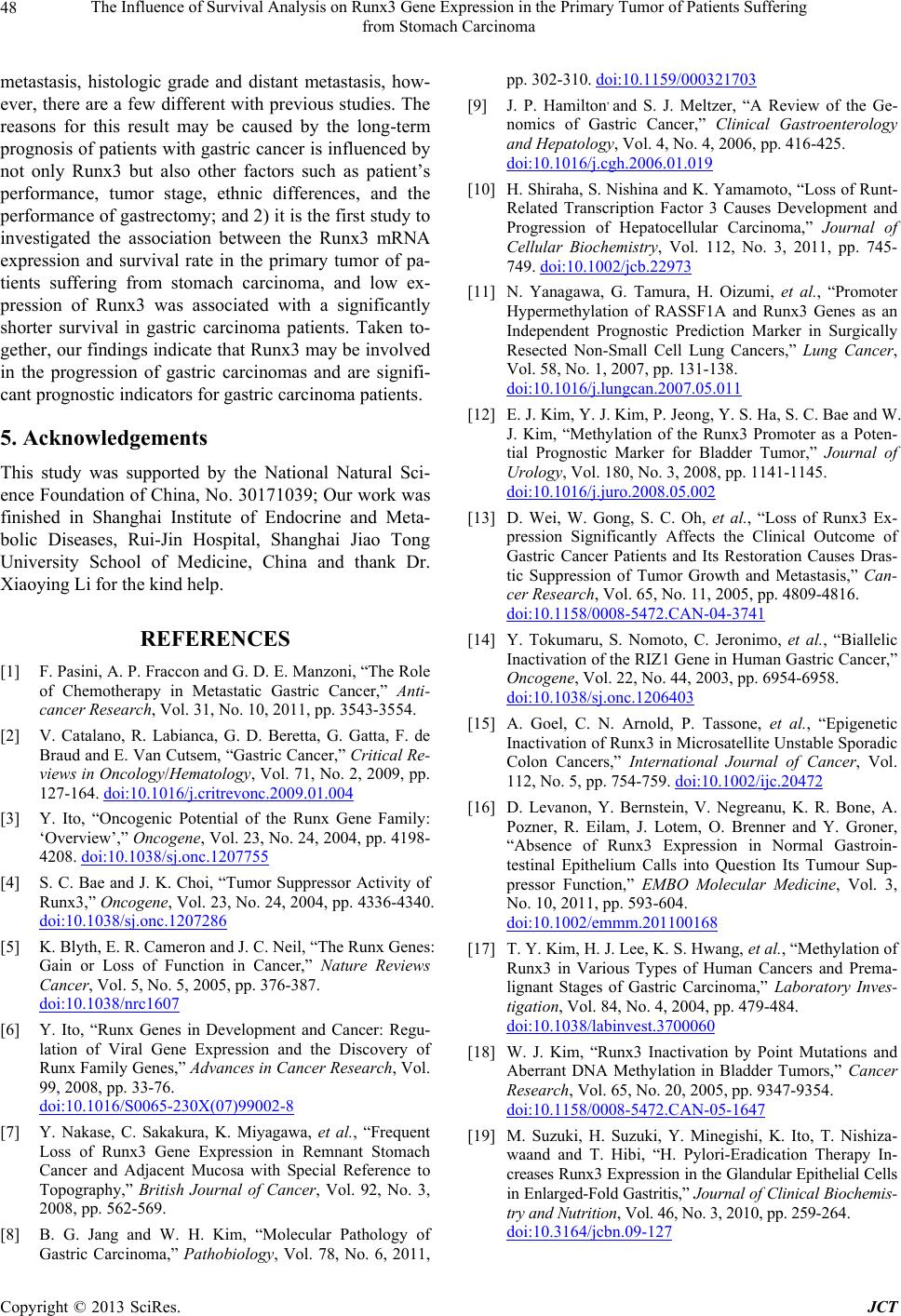
The Influence of Survival Analysis on Runx3 Gene Expression in the Primary Tumor of Patients Suffering
from Stomach Carcinoma
48
metastasis, histologic grade and distant metastasis, how-
ever, there are a few different with previous studies. The
reasons for this result may be caused by the long-term
prognosis of patients with gastric cancer is influenced by
not only Runx3 but also other factors such as patient’s
performance, tumor stage, ethnic differences, and the
performance of gastrectomy; and 2) it is the first study to
investigated the association between the Runx3 mRNA
expression and survival rate in the primary tumor of pa-
tients suffering from stomach carcinoma, and low ex-
pression of Runx3 was associated with a significantly
shorter survival in gastric carcinoma patients. Taken to-
gether, our findings indicate that Runx3 may be involved
in the progression of gastric carcinomas and are signifi-
cant prognostic indicators for gastric carcinoma patients.
5. Acknowledgements
This study was supported by the National Natural Sci-
ence Foundation of China, No. 30171039; Our work was
finished in Shanghai Institute of Endocrine and Meta-
bolic Diseases, Rui-Jin Hospital, Shanghai Jiao Tong
University School of Medicine, China and thank Dr.
Xiaoying Li for the kind help.
REFERENCES
[1] F. Pasini, A. P. Fraccon and G. D. E. Manzoni, “The Role
of Chemotherapy in Metastatic Gastric Cancer,” Anti-
cancer Research, Vol. 31, No. 10, 2011, pp. 3543-3554.
[2] V. Catalano, R. Labianca, G. D. Beretta, G. Gatta, F. de
Braud and E. Van Cutsem, “Gastric Cancer,” Critical Re-
views in Oncology/Hematology, Vol. 71, No. 2, 2009, pp.
127-164. doi:10.1016/j.critrevonc.2009.01.004
[3] Y. Ito, “Oncogenic Potential of the Runx Gene Family:
‘Overview’,” Oncogene, Vol. 23, No. 24, 2004, pp. 4198-
4208. doi:10.1038/sj.onc.1207755
[4] S. C. Bae and J. K. Choi, “Tumor Suppressor Activity of
Runx3,” Oncogene, Vol. 23, No. 24, 2004, pp. 4336-4340.
doi:10.1038/sj.onc.1207286
[5] K. Blyth, E. R. Cameron and J. C. Neil, “The Runx Genes:
Gain or Loss of Function in Cancer,” Nature Reviews
Cancer, Vol. 5, No. 5, 2005, pp. 376-387.
doi:10.1038/nrc1607
[6] Y. Ito, “Runx Genes in Development and Cancer: Regu-
lation of Viral Gene Expression and the Discovery of
Runx Family Genes,” Advances in Cancer Research, Vol.
99, 2008, pp. 33-76.
doi:10.1016/S0065-230X(07)99002-8
[7] Y. Nakase, C. Sakakura, K. Miyagawa, et al., “Frequent
Loss of Runx3 Gene Expression in Remnant Stomach
Cancer and Adjacent Mucosa with Special Reference to
Topography,” British Journal of Cancer, Vol. 92, No. 3,
2008, pp. 562-569.
[8] B. G. Jang and W. H. Kim, “Molecular Pathology of
Gastric Carcinoma,” Pathobiology, Vol. 78, No. 6, 2011,
pp. 302-310. doi:10.1159/000321703
[9] J. P. Hamilton, and S. J. Meltzer, “A Review of the Ge-
nomics of Gastric Cancer,” Clinical Gastroenterology
and Hepatology, Vol. 4, No. 4, 2006, pp. 416-425.
doi:10.1016/j.cgh.2006.01.019
[10] H. Shiraha, S. Nishina and K. Yamamoto, “Loss of Runt-
Related Transcription Factor 3 Causes Development and
Progression of Hepatocellular Carcinoma,” Journal of
Cellular Biochemistry, Vol. 112, No. 3, 2011, pp. 745-
749. doi:10.1002/jcb.22973
[11] N. Yanagawa, G. Tamura, H. Oizumi, et al., “Promoter
Hypermethylation of RASSF1A and Runx3 Genes as an
Independent Prognostic Prediction Marker in Surgically
Resected Non-Small Cell Lung Cancers,” Lung Cancer,
Vol. 58, No. 1, 2007, pp. 131-138.
doi:10.1016/j.lungcan.2007.05.011
[12] E. J. Kim, Y. J. Kim, P. Jeong, Y. S. Ha, S. C. Bae and W.
J. Kim, “Methylation of the Runx3 Promoter as a Poten-
tial Prognostic Marker for Bladder Tumor,” Journal of
Urology, Vol. 180, No. 3, 2008, pp. 1141-1145.
doi:10.1016/j.juro.2008.05.002
[13] D. Wei, W. Gong, S. C. Oh, et al., “Loss of Runx3 Ex-
pression Significantly Affects the Clinical Outcome of
Gastric Cancer Patients and Its Restoration Causes Dras-
tic Suppression of Tumor Growth and Metastasis,” Can-
cer Research, Vol. 65, No. 11, 2005, pp. 4809-4816.
doi:10.1158/0008-5472.CAN-04-3741
[14] Y. Tokumaru, S. Nomoto, C. Jeronimo, et al., “Biallelic
Inactivation of the RIZ1 Gene in Human Gastric Cancer,”
Oncogene, Vol. 22, No. 44, 2003, pp. 6954-6958.
doi:10.1038/sj.onc.1206403
[15] A. Goel, C. N. Arnold, P. Tassone, et al., “Epigenetic
Inactivation of Runx3 in Microsatellite Unstable Sporadic
Colon Cancers,” International Journal of Cancer, Vol.
112, No. 5, pp. 754-759. doi:10.1002/ijc.20472
[16] D. Levanon, Y. Bernstein, V. Negreanu, K. R. Bone, A.
Pozner, R. Eilam, J. Lotem, O. Brenner and Y. Groner,
“Absence of Runx3 Expression in Normal Gastroin-
testinal Epithelium Calls into Question Its Tumour Sup-
pressor Function,” EMBO Molecular Medicine, Vol. 3,
No. 10, 2011, pp. 593-604.
doi:10.1002/emmm.201100168
[17] T. Y. Kim, H. J. Lee, K. S. Hwang, et al., “Methylation of
Runx3 in Various Types of Human Cancers and Prema-
lignant Stages of Gastric Carcinoma,” Laboratory Inves-
tigation, Vol. 84, No. 4, 2004, pp. 479-484.
doi:10.1038/labinvest.3700060
[18] W. J. Kim, “Runx3 Inactivation by Point Mutations and
Aberrant DNA Methylation in Bladder Tumors,” Cancer
Research, Vol. 65, No. 20, 2005, pp. 9347-9354.
doi:10.1158/0008-5472.CAN-05-1647
[19] M. Suzuki, H. Suzuki, Y. Minegishi, K. Ito, T. Nishiza-
waand and T. Hibi, “H. Pylori-Eradication Therapy In-
creases Runx3 Expression in the Glandular Epithelial Cells
in Enlarged-Fold Gastritis,” Journal of Clinical Biochemis-
try and Nutrition, Vol. 46, No. 3, 2010, pp. 259-264.
doi:10.3164/jcbn.09-127
Copyright © 2013 SciRes. JCT